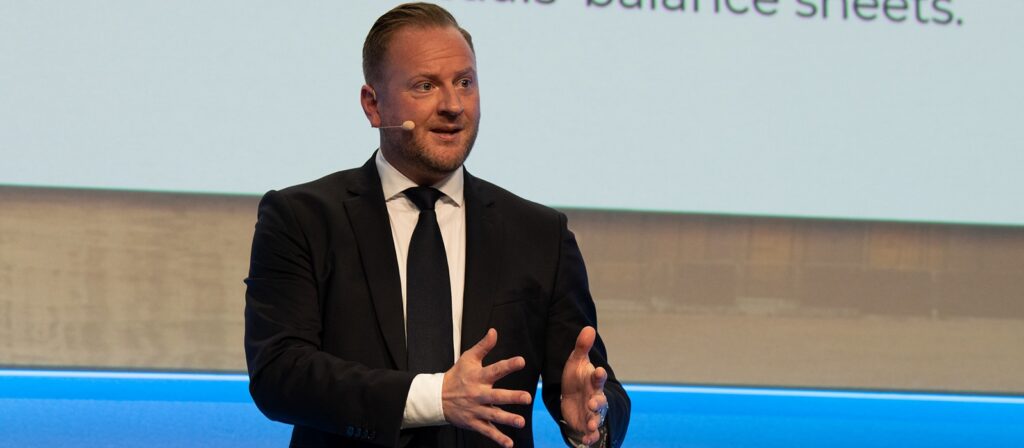I’m going to kick us off. First of all, I’d like to thank ICMIF for the opportunity to share our customer experience story and represent Gore Mutual today. It’s always nice to see that customer experience interest is always alive and well, and so many members signed up. So thank you for the opportunity to share our story today. So today I’m going to take you through our journey at Gore, where we started, what we did, and some of our lessons learned along the way. Hopefully you’ll see some value in this presentation, and you can walk away with a few ideas. Hopefully throughout the breakout sessions you can collaborate, and that stems a little bit the conversation on customer experience with your own teams. So I’ll tell you a little bit more about where we started, to give you a little bit of context.
So about four years ago, Gore Mutual kicked off a major company transformation, which we call our next Horizon strategy. We made tremendous investments in technology, rolling out Guidewire BillingCenter, PolicyCenter, and ClaimCenter. At the same time, our workforce doubled in size and we completely changed our processes and our operating models to fuel our growth. Our model is driven by brokers, so most interactions with customers are in claims. But with this rapid transformation, completely changing processes, technology, operating models, we really needed to relook at our customer experience to understand what those changes truly meant to our policyholders, and ensure that we’re indeed going to effectively improve their customer experience.
Oh, I think I skipped one. So we kicked off, we started by kicking off a 10-week customer experience journey mapping exercise. And during this process, we’ve done lots of customer interviews, focus groups, brainstorming sessions. We also spoke to internal external stakeholders, including vendors. And our goals going into this, were to identify and capture all of interactions, customer interactions from start to finish, and understand all of the customer interactions, and understand how we were actually performing against the customer expectations. A number of important customer interactions were identified through this process, and we refer to those as the moments of truth. So you can think of them as make or break moments. These are the absolute critical interactions with customers that you cannot miss. If you miss those, you are more than likely to turn a good customer into a detractor.
We also wanted to identify the opportunities that we had for us, and understand how we were going to bring them to life. So at the completion of this journey mapping, what we’ve learned… So I’m just going to share early observations at the end of that initial phase. Our customers overall expectations, we found that they’re not insurance specific. In fact, it could be based on their last best customer experience, with let’s say a front provider, a bank, any service really. The needs, however they change. For example, I think we would all agree that all of us would be quite comfortable submitting a healthcare claim online. But if it came down to, let’s say that you have a property loss, and you have two feet of water in your basement, you would much rather probably speak to a human, right? And so the difference here is the emotional drivers involved will actually define the needs for that specific journey.
So you’ll hear me refer to customer journeys, because customer experience is made up of many journeys. They’re not all the same. And so it’s really important that you have a really good understanding of your customer journeys, the emotional and rational drivers, and what we need to do to tailor to their needs. What we found in terms of what our customer valued the most, four things. They really valued proactive outreach, whether at first notice of loss, or when an update is expected. They value quick and empathetic phone responses, and timing is everything here. We’ll get to talk a little bit more about that later. Knowledge and expertise. And that does not only apply to your staff, our internal staff, but it also applies to our vendors.
And when we started mapping out the journeys end to end, it was really enlightening to see that there are really many more interactions with our vendors that actually with our own internal staff. And that really turned our attention to the fact that we needed to have strategic focus on vendor partnerships to make sure that those vendors that are representing Gore Mutual, they’re really acting almost as the face of Gore Mutual. So it’s really important that we picked the right vendors. And then the last one is strong broker relationships. Our customers really valued the broker relationships, since brokers may be quite involved in the claims process as well. And that was also even more evidence in the commercial space than the personal space.
The next phase of our transformation. So after the initial research phase, we started implementing some steps. So the first one was we designed and automated a new net promoter score survey for claims. We started providing awareness training to the frontline on the moments of truth and the pain points. We walked them through the journeys, we explained to them the emotional and the rational drivers, it was very collaborative in nature. And the frontline finally walked away with a chance to understand what really matters to the customers, and really with an understanding and awareness of the moments of truth. And that is really critical for the frontline that are facing our customers, to understand that every time that they are in a moment of truth, that they cannot disappoint the customer, right? They really have to meet or exceed those expectations.
From a tactical perspective, something that we implemented that we found useful, we also introduced email alerts going out to the leaders on all the tractors, and started initiating root cause analysis for all the tractors. Done by the team leaders, because the team leaders own the performance for their own team, we found that they were the best to handle those root cause analyses and look at what happened during the claim, what could we have done better, and ultimately, on a go-forward basis, how do you coach your staff to prevent issues from happening, moving forward? And also obviously logged and reviewed all formal complaints. So since NPS at the time was new to Gore, our objectives were three of them mainly. First of all, we wanted to establish a baseline for NPS. And that was important to us to roll this out in a very smooth way to the staff, so that they get to experience it, and then at some point actually establish a target for that.
The second, was we wanted to identify the low-hanging fruits or the process gaps, and adapt our training plan to address those gaps. And the third one was we also wanted to start shifting our coaching approach on customer experience, to become more objective and data-driven. So obviously, prior to the transformation, we were twice smaller, and we were known as a company to have personable service with our customers. But as you start growing, you are starting to shift your approach to, “How do I make this process scalable, how do I make this process consistent, no matter how big the size of the workforce?” So our focus was really to start looking at a data-driven approach for the leaders to coach their staff and ensure that they’re delivering the perfect service.
Some of the lessons learned in that phase of our implementation. Not surprisingly, a lot of effort required to shift to a customer-centric mindset. It is a journey and a transformation on its own, and that will require iterations. So if you are just starting on this journey, I think it’s important for yourself to understand that there will be iterations. And it’s perfectly fine. It’s probably better to start somewhere, iterate. And create some positive momentum. The second was that. Leaders need to lead by example. They need to be curious. They need to embed customer experience in their coaching habits.
And for the senior leaders themselves, this was a really interesting example, we found that when the senior leaders themselves read the customer comments and discussed the ideas with the frontline managers, it kind of triggered a different kind of thinking for the frontline managers, because it happens once, it happened twice, three times. Then after a while, the frontline managers are thinking, “If my senior leader has time to read the customer comments, I should probably also embed that in my routine.” And then the final point on this is the cadence of coaching. It makes a huge difference. It needs to be discussed often just like other metrics.
And now we’re moving on to our continuous improvement phase. After having set the initial foundation for the customer experience programme with NPS, we started shifting our approach to what it would take for us to have a continuous improvement mindset with regards to customer experience. So some of the things that we started doing, is shifting our coaching and training approach to have more of a long-term outlook to creating a sustainable and scalable model, like I talked about. We also started celebrating high performance more, and addressing concerns much faster. I would tell you in the initial phase of our implementation, I would say probably in the first three to four months, we didn’t see much improvements. And then we quickly realised that it was due to the fact that we used to aggregate the results and wait a little bit too long before we share the results. We were looking for perfection as opposed to be looking for momentum.
And we found that as the feedback comes in, we should be taking the opportunity to celebrate high performance. So accolades, when they come through, whatever recognition system or model you might have in your company, I’d encourage you to use recognition to really celebrate those moments. And also when there are concerns, it has to be dealt with in the moment. We also introduced fun challenges and prizes. So we really wanted to create some excitement. So one of the things that we came up with in the first couple of months, we launched what we call the Battle of the NPS. It was really fun for people, and they had an opportunity to win a prize. So our top three people won different prizes. It was fun, and I think it just created a little bit of excitement around the NPS programme. We also embedded a monthly result in the frontline newsletters and the unit meetings.
So again, in terms of change management, it takes many, many different tactics and strategies for customer experience to really land. And we found that using multiple angles from a communication standpoint worked best for us. Meaning, leveraging the one-on-ones, leveraging the unit meetings, and the newsletters was really effective for us. And then the last point around some of the things that we implemented in that continuous improvement mindset phase. We engage our HR departments to start looking at, with us, the desired competencies we were looking for, for that perfect customer experience to happen. And then we started developing a model around employee competencies that we embedded in our employee experience strategy. And if you think of it in terms of what that means, is looking for the right skillset right from the onset. So embedding those competencies.
So for instance, you want people that have good communication, you want people that are empathetic. So the question is, how do you embed those qualities in your screening process right from the start, from the hiring process? And how do you develop employees throughout their journey as they develop as employees? So that was fully embedded as well in our HR strategy. What we’ve learned in that continuous improvement phase is that for customer experience to work at scale, you will actually need a full strategy and execution plan, and you will need to lead this like a programme. Employee culture is everything. Customer experience needs to be in your DNA, hence why we needed to tie this back to our people strategy. Another one that we learned the hard way, and I’ll talk a little bit more about why that is. General reminders, usually for the most part when it comes to customer experience, they don’t really work. Only specific individual feedback.
We’ll discuss that on the next slide. Our communication strategy with regular cadence really worked well. As part of the programme, we also made sure that we had continuous visibility and celebrations, that is really crucial for most effectiveness. And then the last part of continuous improvement, really comes down to process. And our experience is that we started shifting the way that we looked at process improvements. Because before that, in full transparency, I think we would design processes and create them, thinking that they were very efficient, but we designed them from our perspective. And now what we started doing, is take into account the point of view of the customer and start from there. So we’re actually shifting how we design processes, and now we refer to them as designing from the outside in. Because you start from the point of view of your customer, you leverage the insights, to design a process that’s going to deliver their expectations and address the gaps.
And then our last slide, final slide, leading with data. This is the final phase in our implementation of our customer experience programme. After having identified what matters to our customers, we really started thinking about what are the behaviours that enable those outcomes? So here’s what the customer wants, here are the behaviours that will deliver on that, and then we started looking at what are some of the metrics that will deliver or make sure that we are delivering those behaviours. And we really started delivering or creating metrics and defining those metrics from a behavioural standpoint. So how do we make sure we lock in the right behaviours to then deliver the right outcomes for our customers? So in the next phase of this project, leading with Data, we started creating the dashboards, we started looking at phone stats that we shared weekly by the leaders to the front line during their one-on-ones.
We focused on really what has an impact to the customers. I can give you a couple of examples. So some of the feedback we got initially during our research phase from customers, is we weren’t necessarily responsive, we weren’t necessarily picking up the phone when they called. So we started looking at, okay, how can we address this problem? So we have a phone system. So one of the things that we can look at, is making sure that people are logged in and available to take calls. That is measured, and that’s a goal. We started looking at average wait time, implementing SLAs as part of their goals as well. And we started measuring things like, are we reaching our customers post-FNOL? During the prescribed SLA, we’d also leverage NPS results.
The next thing we looked at is our quality assurance programme. Because that’s an area When we started doing more interviews with customers and employees, we found that our QA programme or audits of the claims files programme was actually creating certain behaviours, and tended to lead to robotic interactions. And that was partly because if you went through what was required on that checklist, there wasn’t a big focus on the customer experience, or it was very, very vague. So what we adjusted in this phase is we now reward for empathy, proactive communication, fulsomeness of answers, quality of customer letters. These are some of the things that we’ve added some weight to, and we tried to also get rid of some of the unnecessary steps in our QA programme.
An important step, another important step that showed our commitment to customer experience, was that our executive members themselves are also embedded in their goals and NPS target, which is reported to our board of directors. And for the frontline, we also set an individual NPS target for each and every employee, so that each and every one of them can own a part of our collective success. Now, I’ll get to some of the things that we learned through the data, and that goes back to why for the most part, general reminders don’t really work. We found through our own data that about 20% of our staff generates 80% of promoters. So our action with this group of employee, the 20% of staff that generate 80% of promoters, was to focus more on rewarding and studying what they were doing well, and embedding it in our trading modules.
Then you have the next 60% of staff that tend to generate average results. And with them, we focused on providing help and coaching to sway neutral customers to become promoters. Because they’re often just missing the little things or the final little touch with the customer. So it’s not necessarily a lot of heavy lifting. But those customers just tend to be more neutral. And then you get to the final 20% of staff that generate 80% of detractors. And we found that with this group, obviously you have to have a different approach. Our approach was to develop individual specific improvement plans, and also giving them a timeline for improvement. Because that is really important. You need to create a sense of urgency. So we would give them basically a timeline for improvement, we would provide all the support they needed, and just make sure that they were meeting expectations from what we wanted to create as far as the customer experience. Hence, why nothing works without a way to measure individual performances.
Obviously, accountability and ownership should be measured through data and metrics. That’s what we do at Gore. Because although CX is an art, there is a lot of science you can use to make sure that you’re creating a better customer experience. So every data point that you can use holds a lot of weight from an employee perspective. They’re starting to feel like they are being measured on objective criteria, and so the more data you can use to measure their effectiveness to customer experience, the better. And my final point, again, I’m going to touch on the recognition aspect. Rewarding great service is as important as being tough and uncompromising on poor customer experience. And that concludes my presentation.





